Hornby's Q1 Class 0-6-0 locomotive
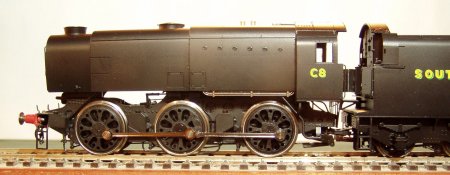 |
photograph by Graham R 'Muz' Muspratt |
| Those people who believe that Hornby are still in the
toy train market can not have taken a close look at their most recent
offerings, especially those of interest to the Southern Modeller. The new found
ethos, of Hornby, to be able to offer within the design of the model a number
of accurate variations, such as on the Bulleid Light Pacifics, is most welcome
and has been continued with the Q1.
The Q1 is one of the most detailed models to emerge from the Hornby Stable to date, such detail includes:
|
| Locomotive |
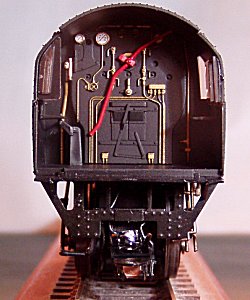 |
Inside the cab of C8, showing the regulator, the fine detail and numbered
dials.
photograph by Graham R 'Muz' Muspratt |
| The model also is fitted with NEM coupling sockets (no
comment on the height of these, as your reviewer does not use them) and small
tension lock couplings (front one supplied loose). The model comes in the usual
window box but with an outer sleeve in the new style which incorporates the
early BR logo. It is worth noting that Hornby has managed to spell Bulleid
incorrectly on the rear of the box!
The models have the extended sandboxes which were added to most of the prototypes during their first visit back to Eastleigh works and which will therefore be incorrect for those modelling the earliest part of their lives. The tender mounted cab doors, however, appear to be based on the original style which were altered, once in service, to meet the cab floor in attempt to reduce drafts in the cab. The other modification at the time was to increase the height of the tender backplate to make tender-first working more comfortable. This Hornby model is with the extended tender back plate. |
| Front of C8 showing the fine detail of the supplied fittings.
photograph by Graham R 'Muz' Muspratt |
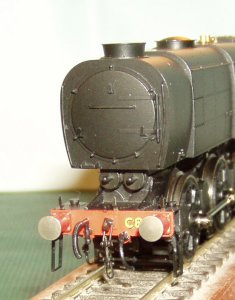 |
| At a little over 220 grams (the tender is approx 110
grams) the model, perhaps some might say like the prototype, is a little on the
light side, but there is room in the body for extra weight if required. All the
wheels, on both the loco and the tender, are used for current collection, and
there are no traction tyres. Slow speeds and smooth running were found to be
superb straight from the box. An 8 pole dual inline NEM 652 socket is included
for DCC, protected by a blanking plug. Your reviewer knows that that there have
been problems with the DCC socket on the initial Hornby Class 50 model, but as
he does not use DCC is unable to advise if the Q1 is also affected.
The main area of compromise with this model is of course the fact that being '00' scale, the frames are closer together than on the prototype. Whilst on most models this is not really all that noticeable, due to the stark design of the Q1 and the very distinct valve chest covers under the smokebox, it does make the compromise more obvious, although not so obvious that your reviewer would lose any sleep over it (with apologies to EM or P4 modellers thinking of converting this model!). |
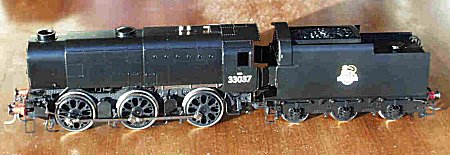 |
The 33037 version.
photograph by Roger Stanford |
| R2342, Southern Livery, C8. There is no lubricating gear fitted to this version, although C8 was one of those retro fitted with the gear before nationalisation so your reviewer would have liked to have seen it fitted, especially as the sandboxes are of the extended version and would have fitted his 1946 to 1949 modelling period! The lettering 'Southern' on the tender and the 'C8' on the cabsides are in 1941 'Sunshine' style. The position of the name on the tender sides varied and Hornby have it in the 'thrown forward' position found on some locos. The model is in presented in ex-works condition. R2344, BR late crest livery, 33009, Weathered R2355, BR early crest livery, 33037 The 33037 BR version came with its chimney detached, so watch out for loose parts - perhaps the Chinese are a bit stingy with the adhesive! As to quartering, on the Hornby model the left side of the motion is leading but on the National railway Museum's C1, presently on the Bluebell Railway, it is the righthand side that is leading. |
| The 33009 version.
photograph by David Cockle |
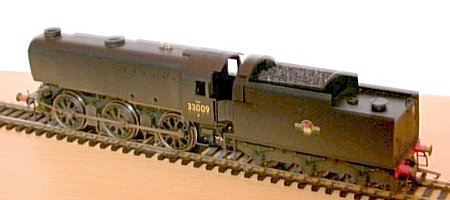 |
| Tender |
| Only one tender version appears to have been made by
Hornby and it is thought that the additional tender top filler hatch is for the
BR water treatment system, and so is probably incorrect for C8 (We would
appreciate confirmation/correction of this) variations.
The bumph does emphasise the 'fine scale' nature of these locos, and the need to handle with care, and this especially applies to the sliding panels at the front of the tender - they spring off very easily as one seeks to ease the tender from its tight-fit polystyrene cradle, whilst the folded doors attached to the tender may also break off. To be honest, yes maybe these sliding panels needed to be applied separately - i.e. could not be successfully moulded integrally - but maybe they are somewhat gimmicky, like the old Tri-ang M7's opening smokebox door and firebox glow. For safe keeping it would be a good idea to use some adhesive to keep them in place. However, for those of you that DO lose the sliding panels before glueing them in place, worry not, as quite a few photos of these locomotives show them as missing completely! The tender chassis is the same as used on the West Country models but with a NEM coupler pocket. If a KadeeNº20 coupling is fitted then the knuckle hangs down marginally low to the Kadee height gauge implying that the NEM pocket may be low, similarly with the loco. The replacement Kadee couplings are also loose in the pocket needing a sliver of plasticard forced in beneath them to tighten them up. We are unsure if the NEM pocket and Kadee º20 combination should be the right height, but this one is far better than Bachmann's efforts so far. The buffer beam has a few unnecessary holes in it. On its top it has holes for plugging in a second ladder as for the WC models, not too noticeable. On the ends of the buffer beams are holes for the lower WC footsteps which are quite obvious in the red painted face. On the right hand side of the chassis is what is best described as a horizontal plate to the buffer beam from the frames, with a triangular front. (This has a slot for the WC footsteps and is missing a vertical triangular plate back to the beam, which should (?) also be on the WC frame?? The left hand side is a different shape which is right. Check with photographs. The tender lifting eyes on the tank top are separate metal fittings, very nice compared with the WC ones which are moulded blobs. If you take out the coal insert you will find another pair of lifting eyes on the bottom of the coal space! Now try and put the coal insert back in....... |
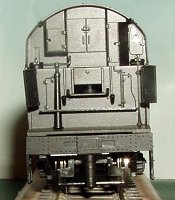 |
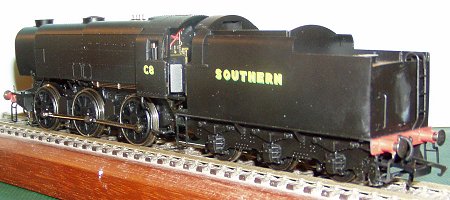 |
| Tender front and side view showing position of
"SOUTHERN" lettering.
photograph by Graham R 'Muz' Muspratt |
|
| One important point on colour, and this is in all the
several colour pictures your reviewers have, is that even quite clean locos
show the pipework as vitually black, not the bronze colour that Hornby has
painted them.
Finally, the model loco and tender lower footsteps are all moulded plastic of a flat strip section. The real rear steps appear to be of a tubular section. Reviewers: Graham 'Muz', Paul Severs and Roger Stanford. |
All photographs are copyright
return to model railway product review index
This page was last updated 27 July 2004